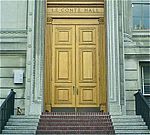Hearst Greek Theatre
1903 establishments in CaliforniaAmphitheaters in CaliforniaAmphitheaters on the National Register of Historic PlacesBuildings and structures in Berkeley, CaliforniaEvent venues established in 1903 ... and 8 more
Event venues on the National Register of Historic Places in CaliforniaGreek Revival architecture in CaliforniaJohn Galen Howard buildingsMusic venues in the San Francisco Bay AreaNational Register of Historic Places in Berkeley, CaliforniaTheatres on the National Register of Historic Places in CaliforniaTourist attractions in Berkeley, CaliforniaUniversity of California, Berkeley
The William Randolph Hearst Greek Theatre, known locally as simply the Greek Theatre, is an 8,500-seat amphitheater owned and operated by the University of California, Berkeley in Berkeley, California, USA. The Greek Theatre hosts The Berkeley Jazz Festival, pop, rock, and world music concerts, UC Berkeley graduation ceremonies, occasional addresses by noted speakers, and other events. Past speakers include President Theodore Roosevelt, William Randolph Hearst, and the Dalai Lama.
Excerpt from the Wikipedia article Hearst Greek Theatre (License: CC BY-SA 3.0, Authors).Hearst Greek Theatre
Gayley Road, Berkeley
Geographical coordinates (GPS) Address External links Nearby Places Show on map
Geographical coordinates (GPS)
| Latitude | Longitude |
|---|---|
| N 37.873694444444 ° | E -122.25419444444 ° |
Address
Hearst Greek Theatre
Gayley Road
94720 Berkeley
California, United States
Open on Google Maps







